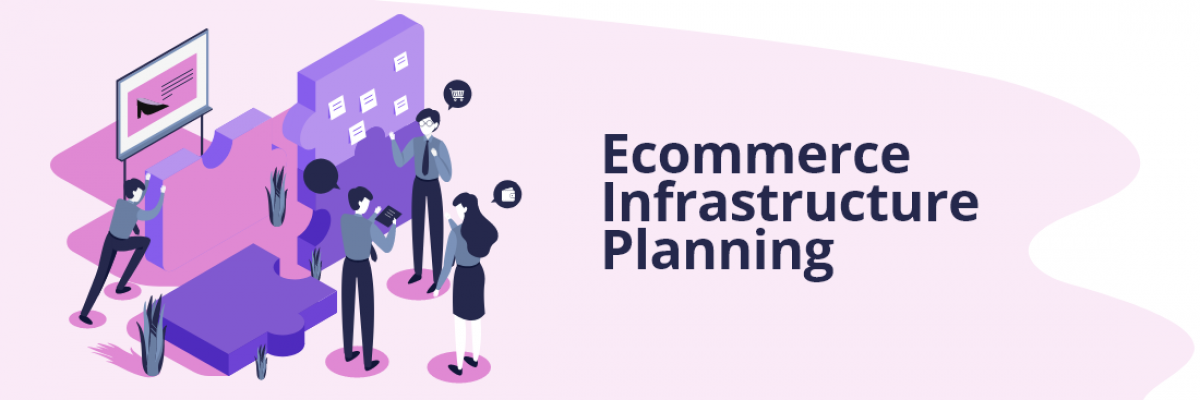Ecommerce Infrastructure: Top influential growth components
In the changing world, there is a necessity to improve the business requirements according to the changing needs of technologies, trends in the market, and customers.
Whether you are new to ecommerce or already into ecommerce, your major priority is to increase the overall efficiency of the organization. When you want to improve efficiency, you must have a strategy and the right infrastructure to address the needs of the user and flexible enough to satisfy their requirements.
Infrastructure is the foundation that makes your business stand out. Ecommerce infrastructure is a collection of hardware, software, network, facilities, etc. that you need to run an ecommerce business. When you have the right infrastructure, you will have an optimized business performance. Here are some important components that you must consider while planning your ecommerce infrastructure.
Ecommerce infrastructure categorization
1. Ecommerce environment: This defines general guidelines and frameworks that will make your business suitable for running ecommerce. It is a standard like technical tools, legal and regulatory frameworks, and the involvement of service providers.
2. Infrastructure services: These are the services that specify ecommerce functions. One or more services will work together to provide particular functions to the ecommerce business. Services like user authorization, payment processing, order validation, etc., help in during products checkout by the user.
The infrastructure services can further be classified in terms of the services they provide to the user or an organization. Network services, directory services, payment services, and security services are common infrastructure service providers to the user.
3. Ecommerce solution providers: They offer an end-to-end solution for ecommerce business who does not have their implementation team.
Ecommerce infrastructure components
Ecommerce infrastructure identifies each functionality of the hardware, software, and network with their key role. When you know about the functionality of the components in ecommerce, then you can organize the ecommerce platform more efficiently.
Hardware:
Hardware does several things, which includes allowing you to connect to your network and have access to the outside world. It allows you to store data, recover and use your data. Some important hardware components are:
Devices: Computers, hubs, routers, data centers, etc.
Servers: Server provides the necessary functionality for other programs. It can be a computer program or a device and can be used for different purposes. Some common servers are a proxy server, web server, application server, etc.
Software:
Software components include services like system management tools, analytic tools for estimating your business and service providers.
Management services: When you run an ecommerce business you need to manage various services like content, database and resources. Enterprise resource planning, content management, and data centers are some software services that help in managing the resources of the company efficiency.
Analytics: Ecommerce business is more competitive since it is growing day by day. So, it's important to analyze your capacity, which helps in improving your system to perform better. Web analytics and text analytics tools will help in estimating your ecommerce site.
Middleware: Middleware is an intermediate between service providers and service users. It could be data access for components, communication protocols, specialized servers, or a mix of all.
API: An application program interface is a protocol or a tool for building the software applications. It specifies how a software component should interact with each other.
Network:
Network provides the communication path and services between users, processes, applications, services, and external networks through the Internet.
Internet connectivity: Establishing the connection between various devices and processes.
Firewalls: Firewalls protect your networks from outside attackers. It enables you to specify what kinds of traffic are permitted through, adding a layer of security.
Security services: Even some times firewalls may lack in protecting against the hackers including security services.
Load balancer: It uses load balancers to distribute the overall load on your web or application servers. It also distributes demand according to the kind of task to be performed.
DNS: Domain Name System is naming a system for your website. They locate the internet protocol address for your domain name.
Criteria for choosing ecommerce infrastructure
Choosing the right infrastructure to match your ecommerce business strategies enables your operations to run efficiently and increase your revenue.
Flexibility: An ecommerce environment must be easy to manage for all users. They must have the ability to respond quickly for all the changes and must adapt the new technologies and features as a scalable factor.
Usability: Usability is an important factor while you are choosing the services for ecommerce platforms. When any one of the services fails, it will cause a major effect in delivering efficient performance.
Scalability: Ecommerce grows rapidly where new technology and services get added regularly so it needs to have an environment that does not collapse during additional services. The infrastructure should be scalable in terms of technology, human recourses, high traffic, etc. Also, the performance of the system should not be slowed down.
Security: Ecommerce business is vulnerable to various sources like hackers, malware, security attacks, etc. Your infrastructure must allow firewalls to protect your ecommerce from network attacks and other paid security services.
Effective planning and management
As an ecommerce business owner, ignoring the importance of planning and developing an ecommerce infrastructure is a major failure for a business in the long run. You need to have an infrastructure based on the needs and priorities of your company. Even managing your ecommerce infrastructure is challenging, but well-defined planning and management can reduce risk and ensure uptime.








